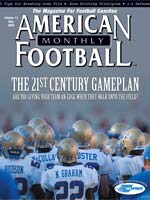AMERICAN FOOTBALL MONTHLY THE #1 RESOURCE FOR FOOTBALL COACHES
Article CategoriesAFM Magazine
|
Video a Necessary Part of Every Programby: Jeff Davis© More from this issue “It was film in the old days, up to about ‘88 or 89,” recalls Clemson’s veteran video coordinator Rick Bagby, a pioneer in his field who led the video revolution that enables football coaches better use their time to develop sophisticated, smart, systems, and, he hopes, winning game plans for the ACC program that’s been a big winner for decades in the South. Across the country in the Pacific Northwest, Steve Pohl has been running Oregon’s football video operation since 1992. “When I got here, some of the older coaches kidded me how they had to splice reels of film.” Indeed, tales of film room sessions conducted by the likes of a George Halas, Paul Brown, Vince Lombardi, and Tom Landry, where every player lived in fear of being called out by the coach and the embarrassment of seeing his mistakes run over and over in ....The full article can only be seen by subscribers. Subscribe today!
|
|
|||||||
| HOME |
MAGAZINE |
SUBSCRIBE | ONLINE COLUMNISTS | COACHING VIDEOS |
Copyright 2025, AmericanFootballMonthly.com
All Rights Reserved





